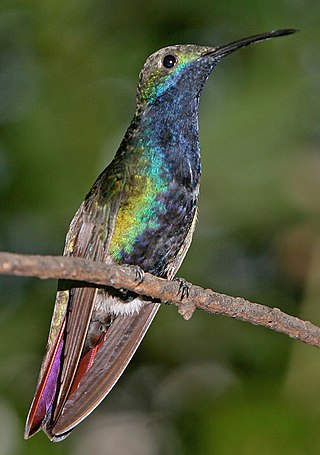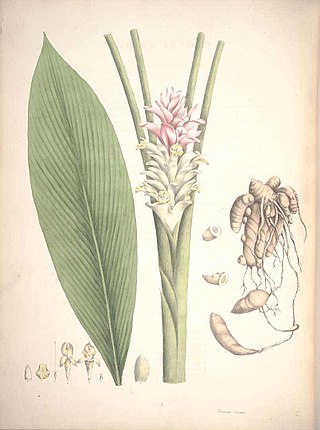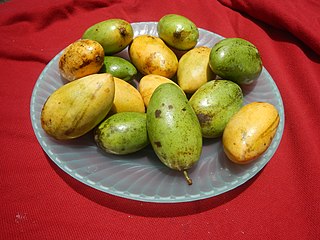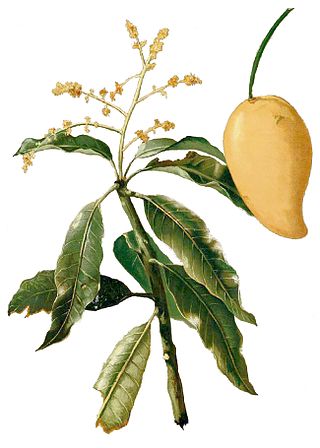
A mango is an edible stone fruit produced by the tropical tree Mangifera indica. It is believed to have originated in southern Asia, particularly in eastern India, Bangladesh, and the Andaman Islands. M. indica has been cultivated in South and Southeast Asia since ancient times resulting in two types of modern mango cultivars: the "Indian type" and the "Southeast Asian type". Other species in the genus Mangifera also produce edible fruits that are also called "mangoes", the majority of which are found in the Malesian ecoregion.

The bell pepper is the fruit of plants in the Grossum Group of the species Capsicum annuum. Cultivars of the plant produce fruits in different colors, including red, yellow, orange, green, white, chocolate, candy cane striped, and purple. Bell peppers are sometimes grouped with less pungent chili varieties as "sweet peppers". While they are botanically fruits—classified as berries—they are commonly used as a vegetable ingredient or side dish. Other varieties of the genus Capsicum are categorized as chili peppers when they are cultivated for their pungency, including some varieties of Capsicum annuum.

The black-throated mango is a species in subfamily Polytminae of the hummingbird family Trochilidae. It is found in Panama, in every mainland South American country except Chile, and in Trinidad and Tobago.

The green-breasted mango or Prevost's mango is a species in subfamily Polytminae of the hummingbird family Trochilidae. It is found from eastern Mexico south through most of Central America, in Colombia and Venezuela, and as a vagrant in the United States.

Curcuma amada, or mango ginger is a plant of the ginger family Zingiberaceae and is closely related to turmeric. The rhizomes are very similar to common ginger but lack its pungency, and instead have a raw mango flavour.

The Dasheri mango is a mango cultivar which originated in a village near Kakori in Lucknow district in 18th century. It is a sweet and fragrant variety of mango grown in North India, the southern state Andhra Pradesh, Nepal, and Pakistan. Malihabad in Uttar Pradesh is the largest producer.

Phytophthora palmivora is an oomycete that causes bud-rot of palms, fruit-rot or kole-roga of coconut and areca nut. These are among the most serious diseases caused by fungi and moulds in South India. It occurs almost every year in Malnad, Mysore, North & South Kanara, Malabar and other areas. Similar diseases of palms are also known to occur in Sri Lanka, Mauritius, and Sumatra. The causative organism was first identified as P. palmivora by Edwin John Butler in 1917.
Peziotrichum corticola is an ascomycete fungus that is a plant pathogen. It was first discovered in India by Massee. Rhinocladium corticola is a known synonym.

The Hispaniolan mango is a species of hummingbird in the subfamily Polytminae. It is endemic to the Caribbean island of Hispaniola.

Mangifera altissima, is a species of mango native to the Philippines and surrounding regions in Indonesia, Malaysia, Papua New Guinea and the Solomon Islands. It is not grown commercially but is harvested from the wild in the Philippines. It has small fruits that are pale yellow when ripe and are very sweet, though much more fibrous than commercially cultivated Mangifera indica species like Carabao mangoes. It is threatened by habitat loss.

Mangifera sylvatica, also known as the Himalayan mango, pickling mango, or Nepal mango, is a species of plant in the family Anacardiaceae. It is found in Bangladesh, Cambodia, China (Yunnan), India, Myanmar, Nepal, Bhutan and Thailand. It is a tree 6–20 m (20–66 ft) tall. The fruit measure 6 cm–8 cm × 4 cm–5 cm.

Mangifera indica, commonly known as mango, is a species of flowering plant in the family Anacardiaceae. It is a large fruit tree, capable of growing to a height of 30 metres. There are two distinct genetic populations in modern mangoes – the "Indian type" and the "Southeast Asian type".

The 'Alampur Baneshan' mango, sometimes spelled Banishan, is a named mango cultivar that originates from India. In southern India, it is sometimes known as Seeri. It differs from, but is related ancestrally to, the high-volume commercial cultivar Banganapalli. However, this is a much older and prized cultivar.

The 'Anderson' mango is a named mango cultivar that originated in south Florida.

Penicillaria jocosatrix, the mango shoot borer, is a moth of the family Euteliidae first described by Achille Guenée in 1852. It is found from southeast Asia to the Pacific. Records include Borneo, Guam, Hawaii, India, Sri Lanka, Thailand and in Australia, Western Australia, the Northern Territory and Queensland.
Dadaga is a village in the southern state of Karnataka, India. It is located in the Nagamangala taluk of Mandya district in Karnataka. A lake and channel of Hemavathi water acts as water supply for irrigation conducted here. Many temples can also be found in this place. Government runs a primary and middle Kannada medium school in Dadaga which educates Dadaga and neighboring villages. Coconuts, mangoes, ragi, paddy (rice), wheat, corn, onions, tomatoes, are some of the plants that are cultivated here.

The 'Amrapali' mango is a named mango cultivar introduced in 1971. It was developed as a hybrid variety of 'Dasheri' and 'Neelum' by Dr. Pijush Kanti Majumdar at the Indian Agriculture Research Institute in Delhi. Since then this mango has been introduced to farms and orchards across India. Amrapali Mango was first planted in West Bengal in Chakdaha, Nadia district. The seed was given by Dr. Pijush Kanti Majumdar.

Mango sticky rice is a traditional Southeast Asian and South Asian dessert made with glutinous rice, fresh mango and coconut milk, and eaten with a spoon or the hands.

The Puerto Rican mango is a species of hummingbird in the subfamily Polytminae. It is found on the Caribbean islands of Puerto Rico, the British Virgin Islands, and the American Virgin Islands.















